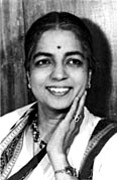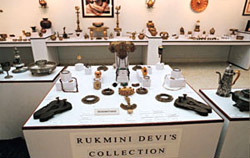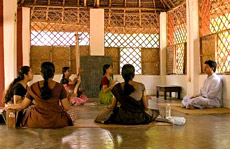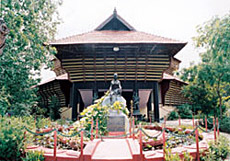 Kalashetra is located in the heartland of Chennai and is the premier institute of Indian classical dance, music and the fine arts. The danseuse Rukmini Devi established it in the year 1936. During the time of its inception, it was called The International Center for the Arts, set up keeping in mind the noble objective of reviving the unique dance form, known as Bharat Natyam. Later it was renamed as Kalakshetra, which means the "Temple of Arts".
Kalashetra is located in the heartland of Chennai and is the premier institute of Indian classical dance, music and the fine arts. The danseuse Rukmini Devi established it in the year 1936. During the time of its inception, it was called The International Center for the Arts, set up keeping in mind the noble objective of reviving the unique dance form, known as Bharat Natyam. Later it was renamed as Kalakshetra, which means the "Temple of Arts".
It was due to her dedication that Kalashetra got recognition in India and also abroad as a hub of excellence, promoting Indian culture. Under her tutelage, the Kalakshetra has been bestowed upon all the national and international prestige for its exclusive mode and aptness.
Over the years it has been grown in leaps and bounds. In the year 1962, Kalakshetra shifted to its huge new campus ground in the locale of Tiruvanmiyur. The beautiful campus stretches up to 99 acres. The Rukmini Devi Museum has also been built comprising of valuable collection of art works like brassware both utilitarian and ornamental, rare  bronze icons, wooden sculpture, glass and ceramic ware, paintings and textiles. Rukmini Devi had collected these valuable materials from various countries.
bronze icons, wooden sculpture, glass and ceramic ware, paintings and textiles. Rukmini Devi had collected these valuable materials from various countries.
What is unique is that this school follows the traditional guru-shisya method of imparting lesson on music, dance, and other art forms. A prominent feature of kalashetra was the incorporation of all modern styles and some local variables. Especially this has been seen in the dance dramas, that Rukmini Devi had composed, thus becoming a quintessence of cultural and social traits of Indian subcontinent.
Among these dance drams, the most important was the Valmiki Ramayana, comprising of six episodes. Careful attention was being given to the costumes and lighting. Moreover, the dance dramas always are accompanied by the melodious music composed by well-known musicians; Music is based on Indian classical ragas, thus setting the tempo of each dance. They are an integral part of the academic curriculum, for the students of the College of fine Arts, a unit of Kalashetra.
Other dance drama forms that have originated from Kalsshetra include Swayamvaram, Rama Vangamanan, Kumara Sambhavam etc.
 Apart from immense contribution of Rukmini Devi, there are quite a many great scholars and musicians. They are Tiger Varadachariar, Mysore Vasudevachariar, Papanasam Sivan, Meenakshisundaram Pillai, Mylapore Gauri Ammal, Veenai Sambasiva Iyer, Budalur Krishnamurthy Sastri, H.Ramachandra Sastri, M.D. Ramanathan, Chandu Panikkar and a host of other geniuses as principals and professors in their respective disciplines. Famous dancers like Yamini Krishnamurthi, Leela Samson and Alarmel Valli, are the alma maters that have truly imbibed the heritage of this prestige institute. Many other famous artists of Bharatnatyam, Kathakali and Carnatic music also took part in building up the institution and maintain the chief traditions in learning and training the pupils. At the end of each year, a spectacular festival occurs at the end of every year and also a beautiful auditorium has been established, following the design of Koottambulam, the conventional theatre of Keral temples. Outstanding performances of the dancers are being presented here.
Apart from immense contribution of Rukmini Devi, there are quite a many great scholars and musicians. They are Tiger Varadachariar, Mysore Vasudevachariar, Papanasam Sivan, Meenakshisundaram Pillai, Mylapore Gauri Ammal, Veenai Sambasiva Iyer, Budalur Krishnamurthy Sastri, H.Ramachandra Sastri, M.D. Ramanathan, Chandu Panikkar and a host of other geniuses as principals and professors in their respective disciplines. Famous dancers like Yamini Krishnamurthi, Leela Samson and Alarmel Valli, are the alma maters that have truly imbibed the heritage of this prestige institute. Many other famous artists of Bharatnatyam, Kathakali and Carnatic music also took part in building up the institution and maintain the chief traditions in learning and training the pupils. At the end of each year, a spectacular festival occurs at the end of every year and also a beautiful auditorium has been established, following the design of Koottambulam, the conventional theatre of Keral temples. Outstanding performances of the dancers are being presented here.
After the death of Rukmini Devi, the Government of India decided to declare the Institution as the center of National Importance. They have largely appreciated the grand traditions of Kalakshetra, and its significance in the cultural scenario of our country and the urgent need of adequate financial support for its continual growth in the coming years. More so, the parliament collectively promulgated an act, namely, "kalakshetra Foundation Act (No. 6 of 1994) ". A Presidential Ordinance preceded this and the Institution was taken over by government took the charge of the Kalakshetra on 29th September 2003.
 With that important step ahead, the Kalakshetra became an independent body of the `Department of Culture, Ministry of Human Resource Development`. A Government Board was formed took after the administration of Kalakshetra Foundation. The Government of India with Hon`ble Sri R. Venkataraman, the former President of India, as its chairman, selects the members of the board.
With that important step ahead, the Kalakshetra became an independent body of the `Department of Culture, Ministry of Human Resource Development`. A Government Board was formed took after the administration of Kalakshetra Foundation. The Government of India with Hon`ble Sri R. Venkataraman, the former President of India, as its chairman, selects the members of the board.
To deal with various financial matters of the Kalakshetra, a Finance Committee was formed. `Financial adviser to the Department of Culture` headed it. Members include the `Director, Department of Culture, Director of the Foundation, a Representative of the State Government, and The Member Secretary of the Government Board,` Numerous academic affairs of the Kalakshetra Foundation run under the supervision of the `Academic Committee, with the Director as Chairman,` Its members are being chosen from various organizations related to authorities in music, crafts and dance.
The Kalakshetra Foundation consists of several units. These are namely Rukmini Devi College of Fine Arts, Besant Cultural Centre Hostel, Craft Education and Research Centre, Besant Arundale Senior Secondary School, Besant Theosophical High School.




